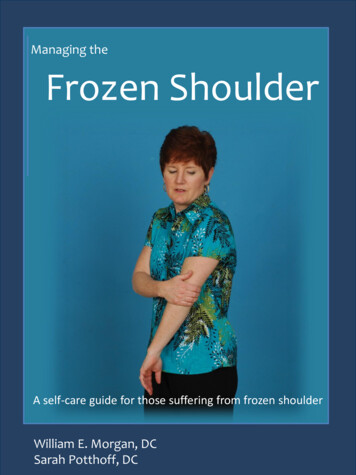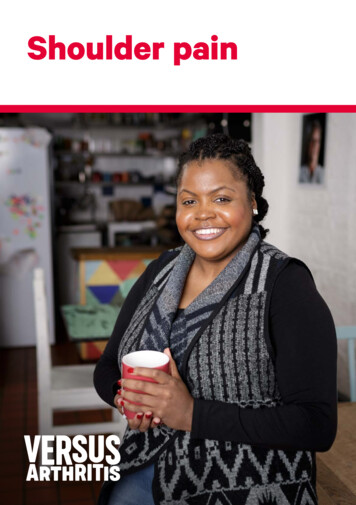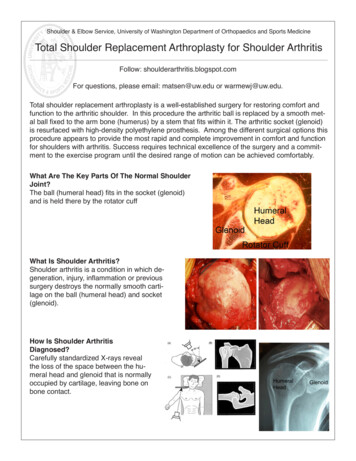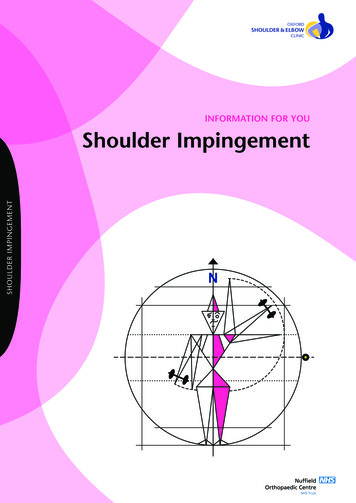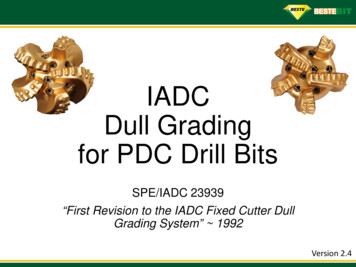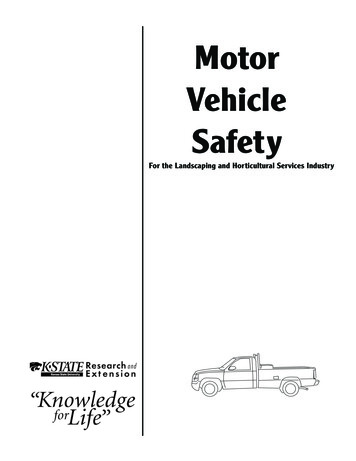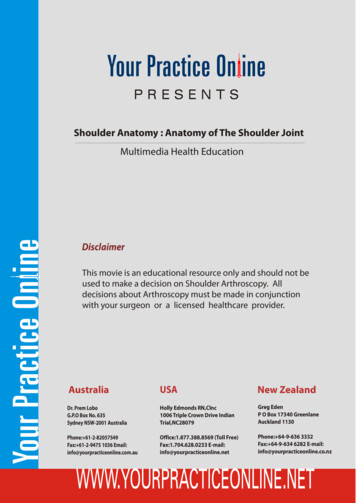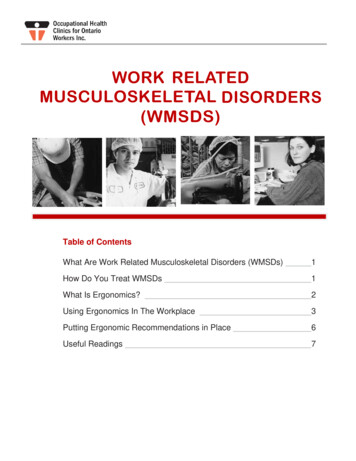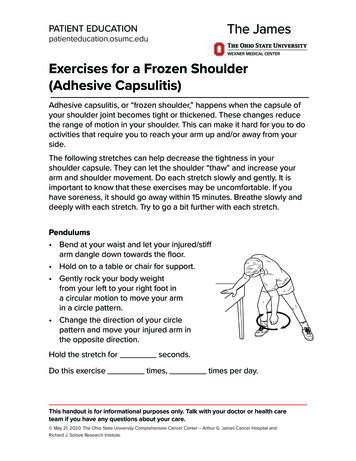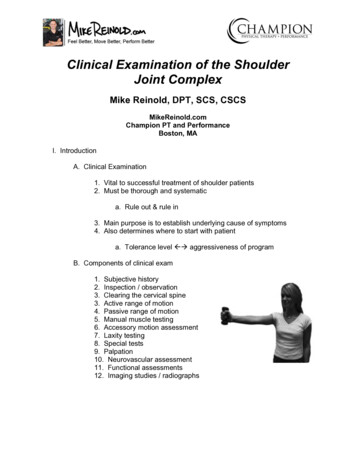
Transcription
Clinical Examination of the ShoulderJoint ComplexMike Reinold, DPT, SCS, CSCSMikeReinold.comChampion PT and PerformanceBoston, MAI. IntroductionA. Clinical Examination1. Vital to successful treatment of shoulder patients2. Must be thorough and systematica. Rule out & rule in3. Main purpose is to establish underlying cause of symptoms4. Also determines where to start with patienta. Tolerance level ßà aggressiveness of programB. Components of clinical exam1. Subjective history2. Inspection / observation3. Clearing the cervical spine3. Active range of motion4. Passive range of motion5. Manual muscle testing6. Accessory motion assessment7. Laxity testing8. Special tests9. Palpation10. Neurovascular assessment11. Functional assessments12. Imaging studies / radiographs
Clinical Examination of the ShoulderMike Reinold, DPT, SCS, CSCSPage 2II. Subjective ExaminationA. Most important part of the clinical examB. Will direct the approach to the objective examinationC. History of symptoms1. What brings you here today?a. Pain, weakness, instability, sensations, etc.2. When did the symptoms begin?a. Acute traumatic incidentb. Insidious onset3. Where, when, & how?4. What alleviates symptoms?5. What reproduces symptoms?6. Chief complainta. Limitations in functional activitiesb. Limitations in work activitiesc. Limitations in recreational/athletic activitiesLooking for “pattern recognition” of symptomsIII. ObservationA. SymmetryB. Posture1.2.3.3.4.Head positionShoulder positionPectoralis positionScapular positionSpine positionC. Atrophy of muscle tissueD. Visible defects1. Ecchymosis, edema, inflammation, deformitiesMikeReinold.com ShoulderSeminar.com
Clinical Examination of the ShoulderMike Reinold, DPT, SCS, CSCSPage 3IV. Clearing the cervical spineA. Dermatomes, myotomes, reflexesB. Active ROM (w/ overpressure), quadrant test, compression/distractionV. Range of motionMikeReinold.com ShoulderSeminar.com
Clinical Examination of the ShoulderMike Reinold, DPT, SCS, CSCSPage 4A. Active range of motion1. Ability to raise arm2. Functional ER/IR3. Assess several factorsa. Painful arcb. Quality of motionc. Quantity of motion4. Scapulohumeral rhythma. 0-30 setting phase; mostly GH movementb. 30-90 2.0-2.75:1 ratio of GH:ST movementc. 90-160 1:1 ratio of scapulohumeral movement5. Scapula movement & wingingB. Passive range of EXTIRERABDAAOS180607090180AMA150509090180Boone JBJS 79166.762.368.8103.7184.0End FeelFirmFirm-hardCapsular10-20 years20-40 years40-54 years60-85 years61-93 yearsBoone JBJS 79Boone JBJS 79Boone JBJS 79Walker Phys Ther 84Downey Phys Ther 8.397.5182.6160385976155MikeReinold.com ShoulderSeminar.com1656580.6157.9
Clinical Examination of the ShoulderMike Reinold, DPT, SCS, CSCSPage 5C. PROM in the athletic populationMotionBaseball Players PROMWilk AJSM 02Baseball Players AROMEllenbecker MSSE 02Tennis Players AROMEllenbecker MSSE 02ERIR129.962.6103.242.4103.745.4D. Assess several factors during PROM1. Quality & quantity of motion2. Crepitus3. End feel (overpressure)VI. Neuromuscular systemA. Resisted manual muscle testingMikeReinold.com ShoulderSeminar.com
Clinical Examination of the ShoulderMike Reinold, DPT, SCS, CSCSPage 6B. Rotator cuff integrity1. Empty can testJobe: AJSM ‘822. Drop arm test3. Lag SignsHertel: JSES ‘96SupraspinatusInfraspintus/Supraspinatus4. Lift-off Sign & Belly PressMikeReinold.com ShoulderSeminar.com
Clinical Examination of the ShoulderMike Reinold, DPT, SCS, CSCSPage 7Gerber: JBJS ‘915. Internal impingement sign – Meister: AJSM ‘00C. Impingement1. Impingement signNeer: Orthop Clin NA ‘772. Hawkins testHawkins: AJSM ‘80MikeReinold.com ShoulderSeminar.com
Clinical Examination of the ShoulderMike Reinold, DPT, SCS, CSCSPage 8D. Biceps provocation1. Static Speed’s test2. Dynamic Speed’s test3. Yer gason’s testYergason: JBJS ‘31VII. Accessory Motion AssessmentA. Assess glenohumeral joint play1.2.3.4.Inferior glidePosterior glideAnterior glideLateral glideMikeReinold.com ShoulderSeminar.com
Clinical Examination of the ShoulderMike Reinold, DPT, SCS, CSCSPage 9VIII. Laxity assessmentA. Grading of humeral head translation – What is normal?B. Seated position1. Sulcus sign – inferior laxity - Neer & Foster JBJS ‘802. Load & shift – gross instabilitySillman & Hawkins CORR ‘93C. Supine Position - Anterior instabilityMikeReinold.com ShoulderSeminar.com
Clinical Examination of the ShoulderMike Reinold, DPT, SCS, CSCSPage 101. Anterior drawer @ 45 - Wilk: JOSPT ‘972. Anterior drawer @ 90 - Wilk: JOSPT ‘973. Anterior fulcrum – Andrews ‘954. Andrew’s Lachman of the shoulderAndrews ‘95MikeReinold.com ShoulderSeminar.com
Clinical Examination of the ShoulderMike Reinold, DPT, SCS, CSCSPage 115. Relocation testJobe Orthop Rev ‘896. Apprehension testD. Supine Position - Posterior instability1. Posterior drawer @ 45 - Wilk: JOSPT ‘972. Posterior drawer @ 90 - Wilk: JOSPT ‘973. Posterior fulcrumNorwood: AJSM ‘84MikeReinold.com ShoulderSeminar.com
Clinical Examination of the ShoulderMike Reinold, DPT, SCS, CSCSPage 124. Push-pull testMatsen: ‘90VIII. SLAP testsA. Speed’s testsB. Grind test“Compression-Rotation”Snyder: Arthroscopy ‘90C. Clunk test / Crank TestAndrews: Inj. Baseball ‘85Liu: AJSM ‘96MikeReinold.com ShoulderSeminar.com
Clinical Examination of the ShoulderMike Reinold, DPT, SCS, CSCSPage 13E. Anterior slideKibler: Arthroscopy ‘95F. Active compression test – O’Brien: AJSM ‘98G. Biceps Load I & II – Kim: AJSM ’99 & Arthroscopy ‘01H. Pain Provocation – Mimori: AJSM ’99 – Increased pain in pronationMikeReinold.com ShoulderSeminar.com
Clinical Examination of the ShoulderMike Reinold, DPT, SCS, CSCSPage 14IX. Acromioclavicular jointA. Spring signB. Shear testDavies: Phys Sports Med ‘81C. Horizontal adductionD. O’Brien’s testO’Brien: AJSM ‘98MikeReinold.com ShoulderSeminar.com
Clinical Examination of the ShoulderMike Reinold, DPT, SCS, CSCSPage 15X. NeurovascularA. Neurological function1. Upper limb tension test (ULTT) – Magee ‘972. Tinel’s sign – Landi ‘793. Dermatomes & ReflexesMikeReinold.com ShoulderSeminar.com
Clinical Examination of the ShoulderMike Reinold, DPT, SCS, CSCSPage 16C. Thoracic outlet1. Roos (EAST) test –Generalized compressionRoos: J Surg ‘762. Adson maneuver – Compression between anterior & middle scalenesor between cervical rib and scalenes. Adson: Ann Surg ‘273. Costoclavicular (Military) test – Compression between 1st rib & claviclein costoclavicular space. Magee ‘974. Allen test – Compression between pectoralis minor and ribs. Allen: AJMed Sci ‘29MikeReinold.com ShoulderSeminar.com
Clinical Examination of the ShoulderMike Reinold, DPT, SCS, CSCSPage 17XI. PalpationA. Specific structures1. Greater tuberosity – rotator cuff insertion2. Biceps brachii (proximal)3. Coracoid process4. Subacromial bursa5. Anterior deltoid6. Infraspinatus – internal impingement location7. Quadralateral space8. 1st rib9. Acromioclavicular joint10. Scapular mobility (crepitus, etc) during AROMXII. Functional AssessmentA. Specific shoulder assessment forms1.2.3.4.5.American Shoulder Elbow Surgeon FormUCLA Shoulder FormJobe-Tobonie Athletic Shoulder FormModified Athletic Shoulder Form – Reinold, Wilk, AndrewsMimori Scoring SystemXIII. SummaryA. Key Points1.2.3.4.5.Systemic approach to shoulder examLogical progressionKnowledge of anatomy & biomechanicsEstablish chief complaintsCorrelate clinical findings to historyWant to learn exactly how I evaluate and treatthe shoulder?My online program at ShoulderSeminar.com is a comprehensive program thatwill show you detailed videos of exact shoulder examination process. There aremodules on shoulder exercises, dynamic stabilization drills, manual therapy,rotator cuff injuries, SLAP lesions, instability, and the stiff shoulder. This 8-weekonline program is approved for CEUs and will help you master the shoulderShoulderSeminar.comMikeReinold.com ShoulderSeminar.com
Clinical Examination of the ShoulderMike Reinold, DPT, SCS, CSCSPage 18ReferencesAdson AW, Coffey JR. Cervical rib: a method of anterior approach for relief ofsymptoms by division of scalenus anticus. Ann Surg. 1927; 85: 839-857.Allen EV. Thromboangitis obliterans: Methods of diagnosis of chronic occlusivearterial lesions distal to wrist with illustrative cases. Am J Med Sci. 1929; 178:237-244.Andrews JR, Timmerman LA, Wilk KE. Baseball. In Pettrone FA, editor. Athleticinjuries of the shoulder. New York: McGraw-Hill: 1995.Andrews JR, Gillogly S. Physical exam of the shoulder in throwing athletes. InZarins B, Andrews JR, Carson WG, editors. Injuries to the throwing arm.Philadelphia: WB Saunders: 1985.Bell, R.H. and J.B. Noble: Biceps disorders, In Hawkins, R.J., and G.W.Misamore (eds.): Shoulder Injuries in the Athlete. New York, ChurchillLivingstone, 1996.Davies GJ, Gould JA, Larson RL. Functional examination of shoulder girdle.Phys Sports Med. 1981; 9: 82-104.Gerber C, Krushell RJ. Isolated rupture of the tendon of the subscapularismuscle. Clinical features in 16 cases. J Bone Joint Surg. 1991; 73B: 289-294.Guidi, E.J. and J.D. Suckerman: Glenoid labral lesions. In Andrews, J.R., andWilk KE (eds.): The Athlete’s Shoulder. New York, Churchill Livingstone, 1994.Hawkins RJ, Kennedy JC. Impingement syndrome in athletes. Am J Sports Med.1980; 8(3):151-8.Hawkins RJ, NG Mohtadi: Clinical evaluation of shoulder instability. Clin. J.Sports Medi. 1:59-64, 1991.Jobe FW, Kvitne RS. Shoulder pain in the overhead or throwing athlete. Therelationship of anterior instability and rotator cuff impingement. Ortho Rev 1989;18(9): 963-975.Jobe FW, Moynes DR. Delineation of diagnostic criteria and a rehabilitationprogram for rotator cuff injuries. Am J Sports Med 1982;10(6):336-9.Kessel, L., and M Watson: The painful arc syndrome. J. Bone Joint Surg. Br.59:166-72, 1977Kibler WB. Specificity and sensitivity of the anterior slide test in throwingathletes with superior glenoid labral tears. Arthro 1995; 11(3): 296-300.MikeReinold.com ShoulderSeminar.com
Clinical Examination of the ShoulderMike Reinold, DPT, SCS, CSCSPage 19Kim SH, Ha KI, Ahn JH, Kim SH, Choi HJ. Biceps load test II: Clinical test forSLAP lesions of the shoulder. Arthro 2001; 17(2): 160-164.Kim SH, Ha KI, Han KY. Biceps load test: a clinical test for superior labrumanterior and posterior lesions in shoulders with recurrent anterior dislocations.Am J Sports Med. 1999; 27(3):300-3.Landi A, Copeland S. Value of tinel sign in brachial plexus lesions. Ann R CollSurg Engl. 1979; 61: 470-471.Liu SH, Henry MH, Nuccion SL. A prospective evaluation of a new physicalexamination in predicting glenoid labral tears. Am J Sports Med.1996;24(6):721-5.Magee DJ. Cervical Spine. Orthopedic physical assessment. Philadelphia: WBSaunders: 1997.Matsen FA, Thomas SC, Rockwood CA. Glenohumeral instability. In RockwoodCA, Matsen FA, editors. The shoulder. Philadelphia: WB Saunders: 1990.Meister BR, Michael SP, Moyer RA, Kelly JD, Schneck CD. Anatomy andkinematics of the lateral collateral ligament of the knee. Am J Sports Med. 2000;28(6):869-78.Mimori K, Muneta T, Nakagawa T, Shinomiya K. A new pain provocation test forsuperior labral tears of the shoulder. Am J Sports Med. 1999; 27(2):137-42.Mosely, H.F.: Disorders of the shoulder. Clin. Symp. 12:1-30, 1960Neer CS 2nd, Foster CR. Inferior capsular shift for involuntary inferior andmultidirectional instability of the shoulder. A preliminary report. J Bone Joint SurgAm. 1980; 62(6):897-908.Neer CS 2nd, Welsh, RP. The shoulder in sports. Ortho Clin NA. 1977; 8(3): 583592.Norwood LA, Terry GC. Shoulder posterior subluxation. Am J Sports Med. 1984;12(1):25-30.O'Brien SJ, Pagnani MJ, Fealy S, McGlynn SR, Wilson JB. The activecompression test: a new and effective test for diagnosing labral tears andacromioclavicular joint abnormality. Am J Sports Med. 1998; 26(5):610-3.Roos DB. Congenital anomalies associated with thoracic outlet syndrome. JSurg; 1976: 771-778.MikeReinold.com ShoulderSeminar.com
Clinical Examination of the ShoulderMike Reinold, DPT, SCS, CSCSPage 20Silliman JF, Hawkins RJ. Classification and physical diagnosis of instability of theshoulder. CORR 1993; 291: 7-19.Wilk KE, Andrews JR, Arrigo CA: The physical examination of the glenohumeraljoint: Emphasis on the stabilizing structures. J Orthop Sports Phys Ther25(6):380-389, 1997.Yergason RM. Supination sign. J Bone Joint Surg. 1931; 13: 160.MikeReinold.com ShoulderSeminar.com
Liu SH, Henry MH, Nuccion SL. A prospective evaluation of a new physical examination in predicting glenoid labral tears. Am J Sports Med. 1996;24(6):721-5. Magee DJ. Cervical Spine. Orthopedic physical assessment. Philadelphia: WB Saunders: 1997. Matsen FA, Thomas SC, Rockwood CA. Glenohumeral instability. In Rockwood CA, Matsen FA, editors .

